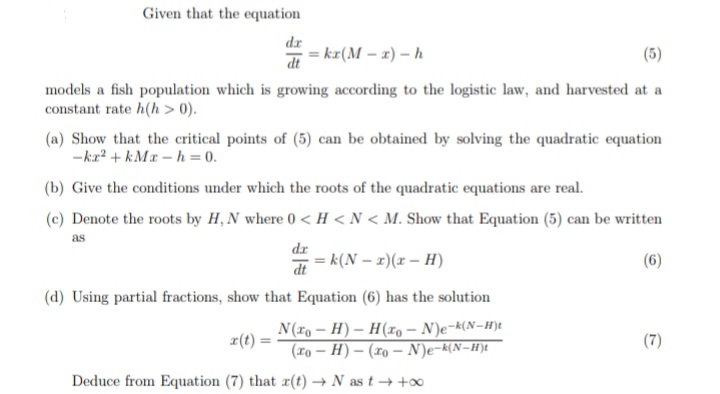dr kr(M- x)-h (5) models a fish population which is growing according to the logistic law, and harvested at a constant rate h(h > 0). (a) Show that the critical points of (5) can be obtained by solving the quadratic equation -ka? + kMx - h = 0. (b) Give the conditions under which the roots of the quadratic equations are real. (c) Denote the roots by H, N where 0 < H < N < M. Show that Equation (5) can be written as dr = k(N – x)(x – H) (6) dt (d) Using partial fractions, show that Equation (6) has the solution N(ro – H) – H(xo – N)e-^(N-H)t (ro - H) – (xo – N)e-k(N-H)t r(t) = (7) Deduce from Equation (7) that r(t) →N as t+o0
dr kr(M- x)-h (5) models a fish population which is growing according to the logistic law, and harvested at a constant rate h(h > 0). (a) Show that the critical points of (5) can be obtained by solving the quadratic equation -ka? + kMx - h = 0. (b) Give the conditions under which the roots of the quadratic equations are real. (c) Denote the roots by H, N where 0 < H < N < M. Show that Equation (5) can be written as dr = k(N – x)(x – H) (6) dt (d) Using partial fractions, show that Equation (6) has the solution N(ro – H) – H(xo – N)e-^(N-H)t (ro - H) – (xo – N)e-k(N-H)t r(t) = (7) Deduce from Equation (7) that r(t) →N as t+o0
Advanced Engineering Mathematics
10th Edition
ISBN:9780470458365
Author:Erwin Kreyszig
Publisher:Erwin Kreyszig
Chapter2: Second-order Linear Odes
Section: Chapter Questions
Problem 1RQ
Related questions
Question
100%

Transcribed Image Text:Given that the equation
dr
= kr(M – x) – h
(5)
dt
models a fish population which is growing according to the logistic law, and harvested at a
constant rate h(h > 0).
(a) Show that the critical points of (5) can be obtained by solving the quadratic equation
-kr? + kMx – h = 0.
(b) Give the conditions under which the roots of the quadratic equations are real.
(c) Denote the roots by H, N where 0 < H < N < M. Show that Equation (5) can be written
as
dr
= k(N – x)(r – H)
(6)
dt
(d) Using partial fractions, show that Equation (6) has the solution
N(ro – H) – H(xo – N)e-k(N-H)t
r(t) =
(7)
%3!
(xo – H) – (19 – N)e-k(N-H)t
Deduce from Equation (7) that r(t) → N as t → +∞
Expert Solution
This question has been solved!
Explore an expertly crafted, step-by-step solution for a thorough understanding of key concepts.
Step by step
Solved in 2 steps with 2 images

Recommended textbooks for you

Advanced Engineering Mathematics
Advanced Math
ISBN:
9780470458365
Author:
Erwin Kreyszig
Publisher:
Wiley, John & Sons, Incorporated

Numerical Methods for Engineers
Advanced Math
ISBN:
9780073397924
Author:
Steven C. Chapra Dr., Raymond P. Canale
Publisher:
McGraw-Hill Education

Introductory Mathematics for Engineering Applicat…
Advanced Math
ISBN:
9781118141809
Author:
Nathan Klingbeil
Publisher:
WILEY

Advanced Engineering Mathematics
Advanced Math
ISBN:
9780470458365
Author:
Erwin Kreyszig
Publisher:
Wiley, John & Sons, Incorporated

Numerical Methods for Engineers
Advanced Math
ISBN:
9780073397924
Author:
Steven C. Chapra Dr., Raymond P. Canale
Publisher:
McGraw-Hill Education

Introductory Mathematics for Engineering Applicat…
Advanced Math
ISBN:
9781118141809
Author:
Nathan Klingbeil
Publisher:
WILEY

Mathematics For Machine Technology
Advanced Math
ISBN:
9781337798310
Author:
Peterson, John.
Publisher:
Cengage Learning,

